Kendrick Brinson
Dec 3, 2011
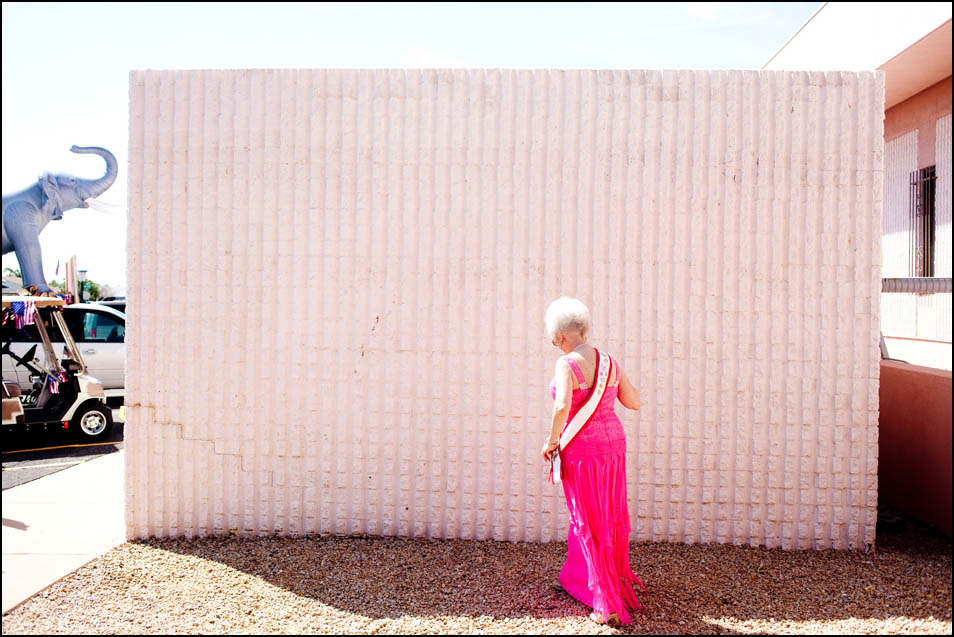
KENDRICK:
This image is one from Sun City, Arizona, which is an age-restricted
retirement paradise near Phoenix. It is an actual city of retirees. The
woman pictured, Herme Sherry, won the Ms. Senior Arizona pageant
in 2004. A woman must be 60 years-old to compete in the pageant
and an Arizona resident. And like any pageant, there is a talent
competition, an interview, and you have to sashay in an evening gown.
The day I photographed her, March 13, 2010, was the 50th anniversary
parade in Sun City and after the parade concluded at the Sundial Recreation
Center, I spotted Herme, along with former winners talking to residents.
Many of the former winners were performing for a crowd that afternoon.
TID:
This image is part of an on-going project, correct?
KENDRICK:
Yes. I first went to Sun City a few months before I photographed
Herme. About a month before that, I was watching a movie at
home and got so distracted by the first five minutes of the movie,
which was pretty inconsequential to the plot, that I started
researching the location immediately on my smart phone. The movie,
"The Savages," starts off with grown children going to a retirement
town to retrieve their senile father. This few minute opening struck
me so much because of the backdrop - tall, spindly palm trees,
cactuses, and matching homes built in the 60s. It seemed like a
real-life scene from the town in Tim Burton's "Edward Scissorhands."
It had the look of a throw-back suburban utopia. I immediately dug
through the web and discovered that short scene was shot in Sun City,
Arizona so I did research on Sun City - all while the movie was still
playing in the background - and read that not only was Sun City the
first place of its kind in the world, but its 50th anniversary year
was two months away.
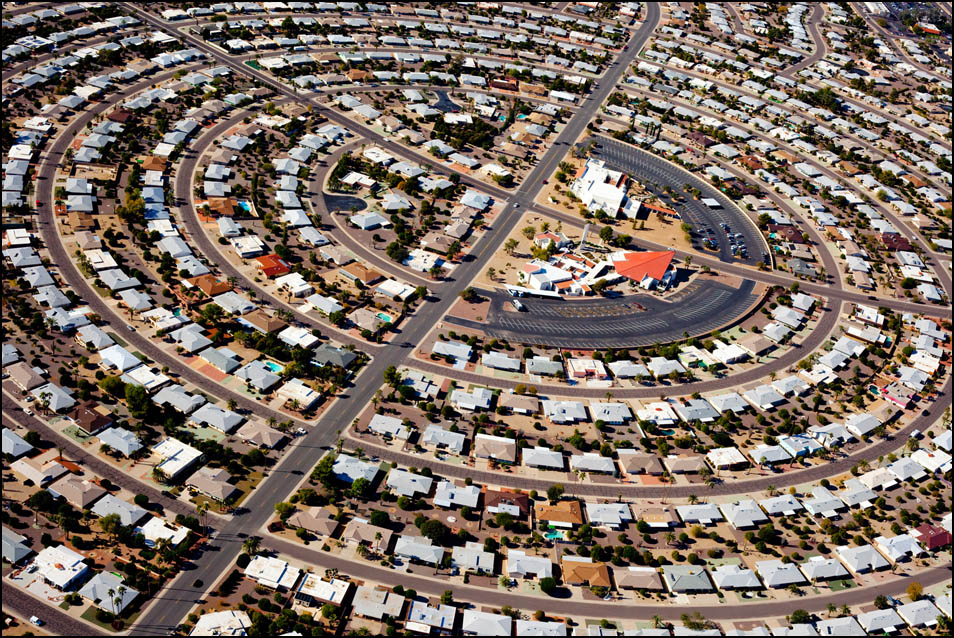
I found information on club after club for residents, including a website
for the Sun City Poms, a cheerleading squad made up entirely of women
55 and older. Immediately, I knew I must photograph in Sun City. Not
only is the place unique, but I had the perfect news hook. I found an old
TIME Magazine cover from the 1960s with Sun City's creator, Del Webb on
the cover and thought I had two built-in possible homes for this story:
AARP Bulletin and TIME Magazine. No editors took my bait before I went,
so after more research and emails and phone calls, I landed in Sun City
about a month later on my own dime.
First, I fell in love with the desert landscape, which was so foreign
to me as I'd spent most of my life in the South. Then, almost immediately,
I was smitten with the people as they are so approachable and friendly
and just about every person I met was eager to help me with my work.
The fact that almost every Sun Citian truly loves Sun City isn't a coincidence,
it is because they chose it over anywhere else in the world to spend the end
of their lives. What makes the place so unique to me, besides the aura of
youth in spite of age, is that this place isn't a neighborhood like so many
retirement communities, it is an actual city made up of 42,500 retirees (and
ten thousand octogenarians), which is mind boggling.
I had no agenda working on this project. It was my first long-term
project that I did entirely on my own - solely because I wanted to. It
was a breath of fresh air not having any editors rushing my images for
publication or trying to shape an edit, as was my experience being on
staff at a newspaper earlier that same year and the years before. All I had to
do was roam and meet people and document this incredibly unique place.
I am really drawn to the concept of living a full life through one's entire
life. As I've spent more and more time in Sun City, I've grown to believe
that a very social and active life is a longer, happier life and that is the
backbone of Sun City's creed. Whenever I come back from a few days I'm
both exhausted and energized because there is always so much going on.
The people I meet there inspire me.
TID:
Now that we know about the project, where does this image fit within
the larger body of work?
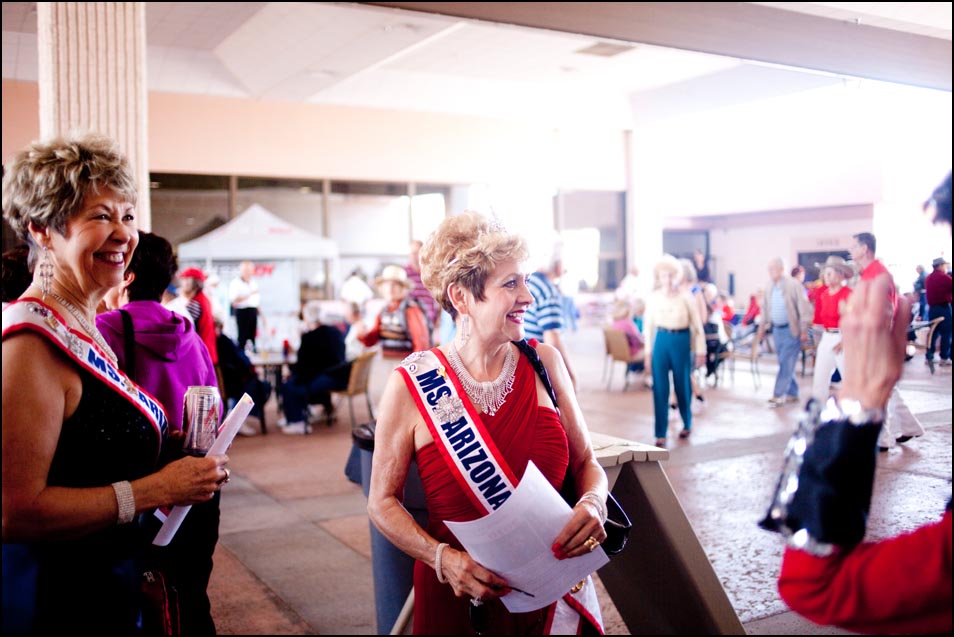
KENDRICK:
The photo I selected from this series isn't of Herme's face, which isn't
necessary because this story is more about a group of people and how
they live. While the individuals are very important in this project, overall,
this is a story about a place and what the people do there and what
makes this place unlike anywhere else. This particular image adds a little
bit of that intrigue for a viewer, I think.
For this project, I photographed a lot of events and activities in the city,
as well as portraits and still life images. I met Herme after the parade and
asked her if I could take a portrait of her. I just loved her beautiful dress.
I talked to her for a bit and then directed her away from the crowd and
towards a wall and I photographed her walking toward the wall and took
a few straight on portraits of her smiling and posing for me. Overall, it was
a brief encounter. This image wasn't a planned image, but I really liked it
when I edited through my take. It was one of the few with the elephant on
the left (it's from a Republican golf cart that was in the parade), which I think
adds to the unexpectedness and quirkiness of the place.
Honestly, this day had so much going on, with the staging before the parade,
the dozens of costumes for all the clubs represented, the parade through town,
that I have to admit, I don't think I even noticed the elephant as an important
part of the scene that I wanted to include. Going through my raw take, I'd
photographed the elephant before and after I photographed Herme, but I'd
originally envisioned a very clean portrait of her. Sun City is full of kitschy
elements - cacti with Santa hats, retirees in Donald Duck costumes, elephants
on golf carts, so the out-of-the-ordinary starts to become overlooked. I'm glad
it makes an appearance in my favorite image from this series, though, because
it adds that certain Sun City kick that seems to sneak into so many frames.
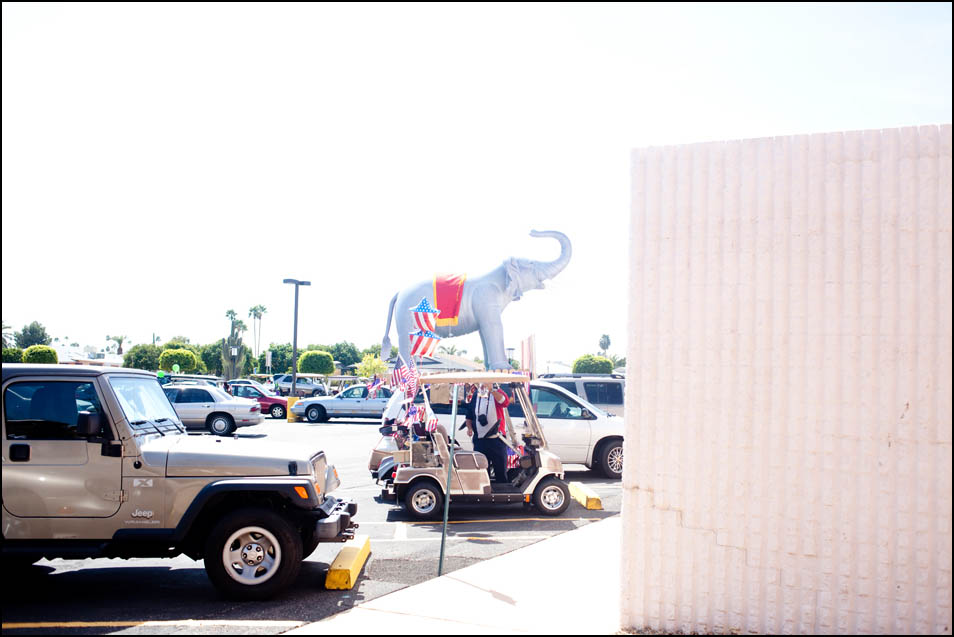
Furthermore, the image of Herme is the start of a trend I've noticed in my
work. I often photograph my subjects before everything is perfect - as they
walk away from me to get into place, after the portrait is over, as they're
laughing, as we're talking. Sometimes that less choreographed image is the
most genuine or beautiful from a shoot. I used to chalk these images up as
outtakes, but now I've started to appreciate their value and include them in
my selects more and more.
TID:
What surprised you during this shoot?
KENDRICK:
I am always in a state of awe in Sun City because it is full of such
vibrant people who do so much with their time. I was less surprised
with this quicky portrait and more surprised by liking this image the
most while editing later. I feel like I'm always moving in Sun City, going
from event to event or walking the streets hunting for people to
photograph. I shoot a whole lot every day and while some days I have a
schedule mapped out, I never know exactly what I will be shooting and
what exact image I want or need. When I photographed Herme, I didn't
know that an image of her would make the essay.
TID:
What was her reaction during the making of this image, and what did
she think about it?
KENDRICK:
Herme was very friendly and gracious. She was happy to have her
portrait taken. Regretfully, I did not grab her contact information.
I'm curious as to what she would think about me selecting an image
of her back, rather than her lovely front for this series.
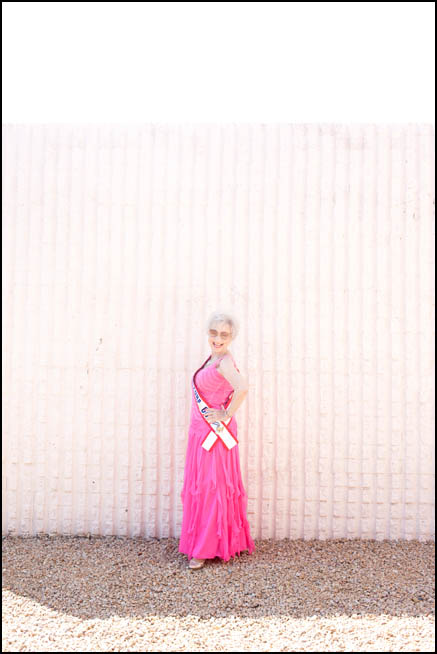
TID:
What has surprised you during the making of the larger project?
KENDRICK:
Something that surprised me with about this project was the freedom I
felt. I hadn't really taken the time and energy to work on a project
solely because I was interested in it. I get to spend my days there
photographing whatever I want, whenever I want and then edit it down
however I want. This freed up a lot of creativity and endless ideas about
where I wanted the project to go and what I wanted to include.
TID:
You mentioned you felt a lot of freedom. Can you recall a moment
when you felt some pushback on access?
KENDRICK:
When I spoke of freedom, I meant the freedom to shoot whatever I want
because it was a story I pursued on my own. No one sent me there initially
and no one told me what I had to come back with. That kind of freedom
in a project is so liberating and also a little overwhelming. I could take the
story down so many different paths - I could photograph death, I could
focus on one couple, I could only photograph the dozens of clubs, I could
photograph the young people who work in a city full of retirees. In a
city that large there were limitless possibilities for what story I could tell.
The way I handled that question came organically; each person I met was a
door and path to more people and more people. What originally drew me to
the place was its uniqueness overall, so I decided not to focus too tightly and
to photograph the people who live there simply doing what they do.
I was very, very fortunate to have been welcomed into home after home.
I have no memories of people saying no to me, and if they did, they
would offer me a friend who was interesting and who led to another path
for the story to expand.
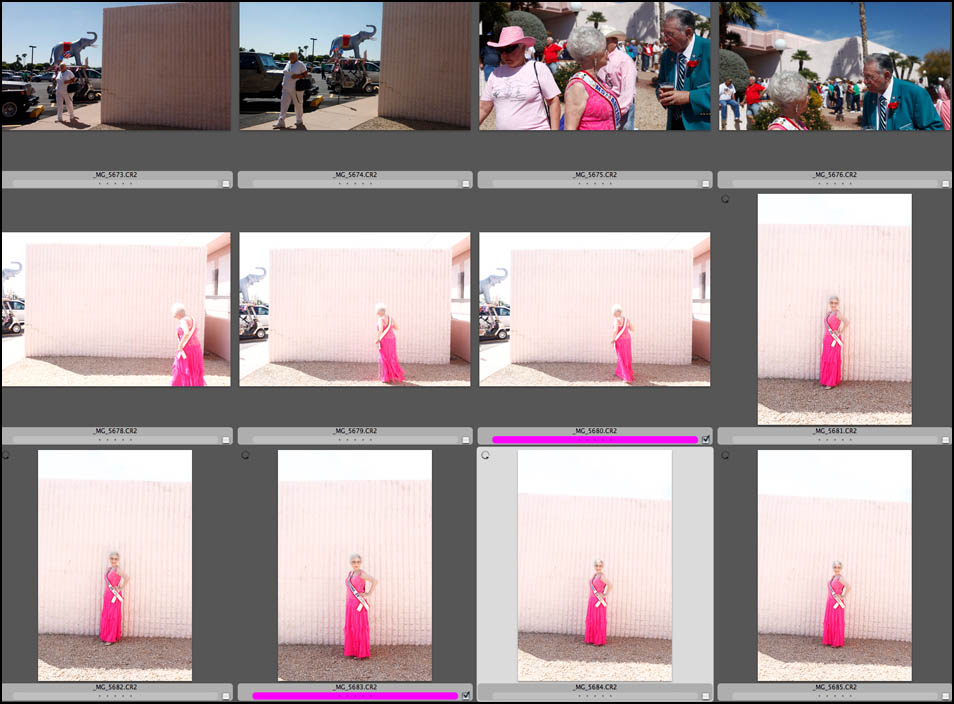
A very tough thing for me to deal with on this project was reality - it has
served as an emotional pushback for me. This place almost seems unreal,
energy is everywhere, despite the gray hair and wrinkles. On my first trip,
I wandered the graveyard for a bit and it reminded me of the finality of
aging that is so easy to forget in a place like Sun City. I think most people
think of communities of old people as places where funerals take place
and of long hospital hallways full of people in wheelchairs. Somehow all
of that is so easy to forget in Sun City and though I'd be reminded when a
man told me about his late wife or one of my hosts told me about losing
a dear friend on the tennis team, the living is what is so profound and
overbearing in Sun City. I would often forget the darker side of aging.
My last trip to Sun City, almost exactly one year ago, was for TIME Magazine
and I saw a man die, bleeding on the pavement in front of me. I was so very
upset that I decided then that I couldn't go back, it was too overwhelming to
have the spell broken. I also photographed a funeral a day or two later (I
had previously chosen not to photograph death in Sun City, but this specific
funeral was very important because the man died in a very youthful and
adventurous way and his funeral was a huge celebration.) The illusion of youth
in Sun City had made me forget what everyone tries to forget in Sun City -
that we don't last forever. That being said, I haven't been back, but I'm ready
to go back now. I miss Sun City and I don't think I will ever be able to say I am
done with this project. Y'know, it's really nice to forget again and again that
aging comes with pain and loss.
TID:
What have you learned about yourself in this project?
KENDRICK:
I've learned that pushing myself and making goals can really pay off.
When you start working on a project, you can come back with lots of
great images, especially if it is in a new, foreign place. The second trip,
you come back with less selects, and you have to push through certain
obstacles that are holding you back. The third trip, you have to push
further, but you'll still come home with less photos you love. I had to
learn that it didn't mean I wasn't working as hard if I didn't have ten new
images to replace older ones, it meant I was spending more time getting
to know the people - sleeping at their houses, driving their golf carts -
and that the less obvious images now had to be made. I had to push
through the "but I've already shot that" and keep shooting each trip and
keeping meeting new people, and I did. In fact, my last trip I took, those
images made up half of my 12 images in my Houston Center for Photography
Fellowship show in June. I'd thought I was done with the project before
that trip, which told me there are still many more images to be made.
TID:
How many times have you photographed out there?
KENDRICK:
Over the span of one year, December 2009 to December 2010, I
photographed in Sun City five times. The trips have varied between
three to seven days. One of those trips was for AARP Bulletin and
another was for TIME. It is AWESOME to have the support from
editorial clients for long-term projects.
TID:
What do you ultimately want to achieve with this work?
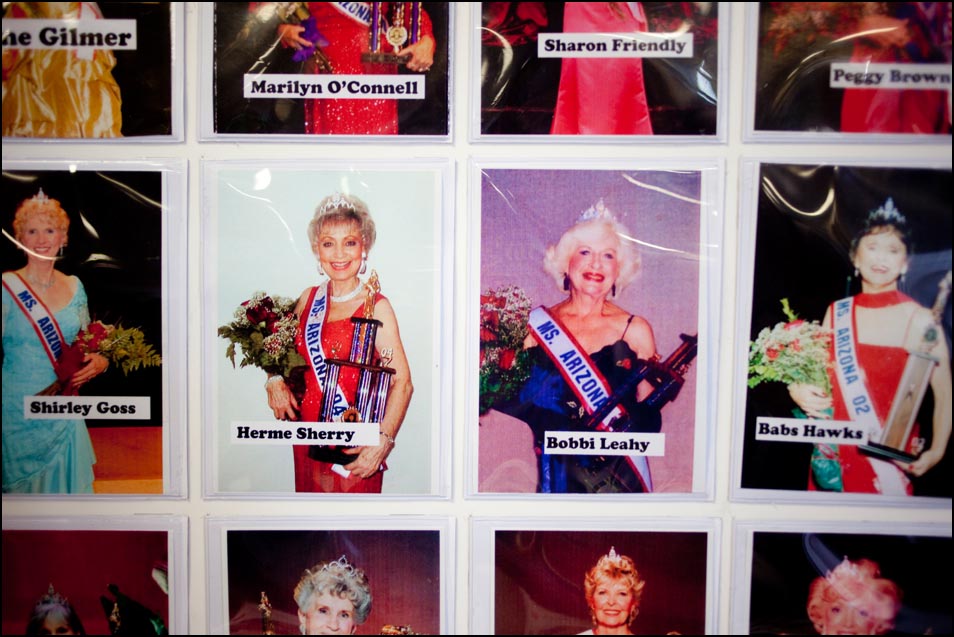
KENDRICK:
I first went to Sun City out of curiosity. I had to see this peculiar,
beautiful place. I also had two clients in mind from the start that I
hoped might bite on a pitch about the story, and ultimately, both of
those clients ended up supporting the project. Since then, the work
has appeared internationally in galleries, as well as in international
publications. This project does not have some all-encompassing,
important message that will change the world, although I think it is
a story that breaks down the ideas we have about aging. So many
people work their whole lives raising children and going to their 9 to 5
jobs, but then retire to do nothing. I love that the people in Sun City
are members of clubs, they are learning new things, meeting new
people, and living the type of life that many people associate with youth.
Why can't someone's 70s be the prime of their life? Often in the media,
we see the elderly in wheelchairs or hospitals. My goal was to show
aging as a thing of living, not a thing of dying.
TID:
You work with LUCEO. Can you talk about how this image, this project fits
in with your organization?
KENDRICK:
LUCEO Images' mission is to support long-term documentary photo
stories and essays. Just about all our efforts revolve around that goal.
Each LUCEO member must have two projects in a review at our meeting
in January each year, as well, because this is so important to our mission.
The group was a huge help in pushing through tough days, in editing
from the road, in making me continue working on the project when I
thought it was done. It is so nice to have five pairs of eyes that have
watched this project grow from the start and who can help push me to
work harder.
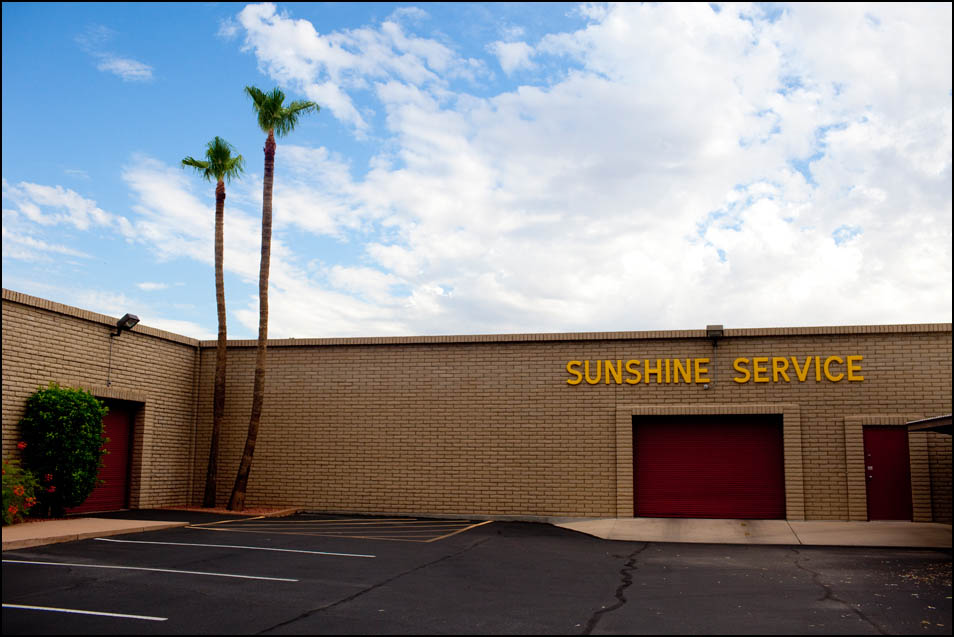
TID:
What advice for other photographers do you have?
KENDRICK:
My advice is to photograph what interests and pulls you, even if it isn't
necessarily the path you think you are supposed to take. If you're just
going through the motions doing what you think a photographer is
supposed to do, your images will be soulless. Years ago, in 2004, when
I was just starting to call myself a photographer, I thought I would be a
photographer whose mission was to document tragic, gritty photojournalistic
stories that would make people weep and want to change things immediately.
That idea is drilled into your head when you look at the winning images of
annual photo contests or walk into many photojournalism classes and while
I think those stories are very important, they're not the only stories that
need to be told. Luckily, I spent my most formative years working on staff
at newspapers and that time was spent documenting stories that were tiny
in the grand scheme of things and I realized how important and valuable
those stories are.
TID:
Finally, how do you think making this image, and
working on this project has changed you as a person?
KENDRICK:
Working on this project has made me want to be more like the people in
Sun City. Right now, the majority of my time and energy revolves around
photography. The days are long, and while it is very fulfilling and I am so
grateful for it, I would like to be a person who learns new things every day,
who puts on a sequined leotard and tosses pom poms in the air and then
goes to a dance and learns the foxtrot and learns how to make a chair in
the wood shop. I think I'd like to step outside my comfort zone more and
make more time to be a more balanced and social person. Just as soon as
I get done with shooting, and editing, and emailing, and toning...
++++

Kendrick Brinson is a photographer based out of Atlanta, Georgia. She worked full-time as an intern and a staff photographer for newspapers for over three years after receiving a journalism degree from the University of Georgia in 2005. In 2009, she left the world of being a staff photographer to pursue personal projects and to work full-time with LUCEO Images. Her current photographic interests include exploring the Deep South, as well as aging in the retirement paradise of Sun City, Arizona, for which she received the 2011 Houston Center for Photography Fellowship, as well as a nod by Critical Mass and inclusion in the 2011 Noordelicht Photofestival. In the past year, "Sun City: Life After Life" has been displayed in eight gallery shows. Kendrick's clients include TIME Magazine, Atlanta Magazine, AARP Bulletin, US News & World Report, and The FADER, among others.
You can view her work at:
http://blog.luceoimages.com/photographers/kendrick-brinson/
(editor's note - Brinson just bought a return ticket to continue exploring her project)
+++
Next week we will take a look at this intimate sports-related image by Adrienne Grunwald:
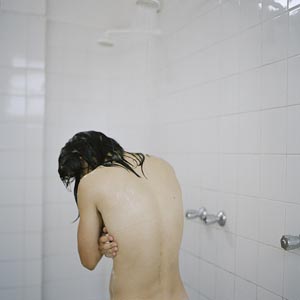
If you have any suggestions, or if you want to interview someone
for the blog, please contact Ross Taylor or Logan Mock-Bunting: